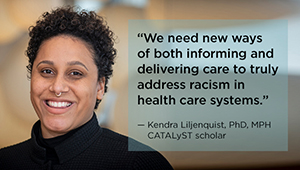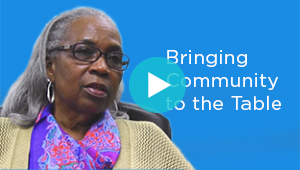How to make research communications more inclusive

The ACT Center’s Jessica Ridpath (L) and Sunday Brush (R) lead a discussion with their team about updating the Checklist for Inclusive Communications.
New ACT Center checklist encourages thoughtful language and design choices
Soon after the Center for Accelerating Care Transformation (ACT Center) launched in 2021, the team gathered to discuss ways to support a key goal: advancing equity in health care research. One priority that emerged was to ensure ACT Center communications were thoughtful and inclusive in all areas of the center’s work.
From this discussion, a new resource took shape: the Checklist for Inclusive Communications. Initially created for internal use by the ACT Center — which is part of Kaiser Permanente Washington Health Research Institute (KPWHRI) — the checklist is now available to anyone seeking guidance on language and design choices that promote inclusivity in research communications.
Jessica Ridpath, who leads communications for the ACT Center and the Kaiser Permanente Social Needs Network for Evaluation and Translation (SONNET), was part of the work group that created the checklist. Below, she shares how they developed this resource, what it offers, and how a personal connection helped inform her work on this project.
Creating and curating a checklist like this sounds challenging. What was your process for putting it together?
We brought together a small work group, including my ACT Center colleagues Sunday Brush, Jess Mogk, and Kelsey Stefanik-Guizlo — along with members of KPWHRI’s communications team. We started by identifying some guiding principles and scanning existing equity-focused communications resources to inform the specific content we wanted to include.
Then I did the initial draft to narrow things down, because creating a resource like this is like trying to boil the ocean. We could go on for 40 pages and still not cover every possible consideration. Our goal was to make a checklist that was comprehensive enough to make an impact but not so deep and broad that people would be overwhelmed by using it.
So, we started with 3 key principles: respect, inclusivity, and awareness.
- Respect is describing and depicting people in a person-first way that reflects how they see themselves.
- Inclusivity is describing people in a way that reflects diversity and doesn't exclude or stigmatize folks.
- Awareness is broad, but it means being thoughtful about your word choices and keeping in mind that people have different needs in terms of language and design. What is going to be accessible to people and what will they easily understand?
And then for each of those principles, we broke it down into specific examples of ways to make language more inclusive and respectful. One example is using descriptive language such as “older adults” and “people who are experiencing homelessness” instead of labels such as “the elderly” and “the homeless.”
Another example is using nongendered language, like “pregnant people” instead of “pregnant women” because not all people who are pregnant identify as women, even if they were assigned female at birth. And making simple changes — like using “children” instead of “boys” and “girls” if you're talking about a pediatric population.
This is where I have a personal connection to the checklist. My son is trans, and I've been on a journey to learn how to communicate in a respectful and inclusive way when I talk with him or about him and his community. This gave me both inspiration and ideas for the checklist, and I was fortunate to be able to brainstorm other ideas with colleagues at KPWHRI whose families are part of the LGBTQIA+ community.
How is the checklist tailored for research communications?
Our goal was to provide specific examples that highlight communications challenges in a research environment — and to spark ideas for how to say and design things differently.
Thinking about social health, for instance, instead of saying “the poor” or “poverty stricken” — which really brings this negative connotation to a person’s circumstances — you can say “people with lower incomes.” Or, if a study is looking at people with incomes below a certain amount, just be specific: “Our study population included people with a household income of less than $30,000.” Then you're not putting any sort of judgment on it. You're just giving the facts.
Other phrases we recommend in the checklist are things like “communities that are underserved by X or Y,” and “populations traditionally not well served by the health care system,” as alternatives to single words like “vulnerable” or “marginalized” that you often see in research. The preferred phrases may be longer, but they appropriately call out the inequitable systems that create these circumstances instead of labeling the people who are in them.
Beyond language, what other aspects of inclusive communications does the checklist cover?
The work we do in the ACT Center is also about design, accessibility, and imagery. So, the checklist provides specific examples of photography that helps break down stereotypes and reflects diversity in race, body size, ability, sexual orientation, and family makeup.
For example, on one side we show a typical picture with a fit, attractive white man leading a meeting. Then we provide an alternative: a similarly composed photo with a Black woman leading the meeting. Another choice would be to show someone who uses a wheelchair in a leadership role. In reality, people of all races, genders, and abilities are leaders, and it’s easy enough to choose a photo that breaks down stereotypes on what leadership looks like.
In creating the checklist, we also considered folks for whom reading is a challenge or who have color blindness or don't see well for another reason. We recommend using font sizes that are big enough and colors that are high-enough contrast to make sure people with different visual abilities will be able to read and understand the content. We also recommend using tools like the accessibility checker in Microsoft Word. This section of the checklist was led by Sunday Brush, who has been the ACT Center’s main champion for promoting accessible design.
Finally, we give folks links to other resources for inclusive communication, including resources on plain language. As health researchers, we tend to use very specialized terms — it’s almost like we speak our own language. This checklist provides a reminder that not everybody speaks that language with us — and that it shows respect for research participants and saves them time and effort when we use plainer language.
What do you see for the checklist moving forward?
I see the checklist as a way to engage health care researchers in thinking about equity in their communications and to inspire them to continue to learn from the wealth of inclusive communications resources available.
But inclusive communications is just one piece of the puzzle when thinking about advancing equity in health research. Equity needs to be considered at every step of the research process, which is why the ACT Center also created the Project Lifecycle Checklist on Integrating Health Equity. This resource covers key questions, example activities, resources, and best practices that can help ensure equity is integrated into all phases of a research project — from scoping and planning to analysis and dissemination.
Language and best practices for advancing equity are always evolving, and these checklists reflect a moment in time. That's why we're committed to reviewing them annually and why we’re hoping to get feedback. We ask people who use them to email us at act-center@kp.org if they have ideas for new resources, new terms or examples to add, or any other suggestions on content or usability. We'll consider all suggestions in our next annual review, which will be in spring of 2025. Our ultimate goal is to keep these resources relevant and up to date as the equity landscape continues to evolve. This will always be a work in progress, for sure.
Visit the ACT Center

Moving research into action, together
KPWHRI’s Center for Accelerating Care Transformation improves health for people and communities by streamlining the path from research to practice.
Equity, inclusion, diversity

Our 2023 EID highlights
At KPWHRI, we prioritize EID across all aspects of our work: our research, our workforce, and engaging with communities.
News

A call for stronger focus on health equity in learning health systems training
Early-career scientists provide steps to a more equitable future.
Video

Bringing community to the table
KPWHRI research partner Neely Williams shares her views on hesitancy in health research in the Black community.


